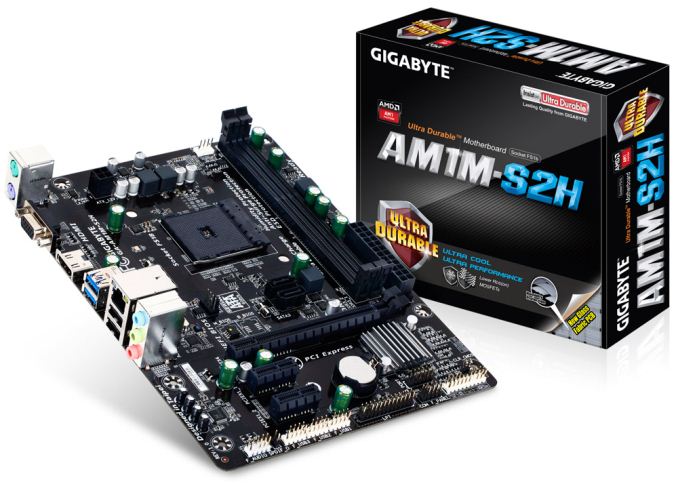GIGABYTE AM1M-S2H Review: What Can $35 Get You?
by Ian Cutress on August 15, 2014 3:00 PM EST- Posted in
- Motherboards
- AMD
- Gigabyte
- Kabini
- AM1
GIGABYTE AM1M-S2H Conclusion
Low cost, low power motherboards are difficult to conclude. With high end motherboards containing controllers and where we discuss performance, it is easy to rule out $20 of controller improvements for a better overclocking range. But when the whole motherboard is $35, and the motherboard/CPU/DRAM combo for $120 or so, it all comes down to the market.
If we imagine a digital signage seller, in the prototype stage they will buy a set of units in order to design the system. Because the motherboards are cheap, if they accidentally get the wrong one, then buying another is relatively trivial. The same goes for replacement parts: rather than take the time to RMA, it becomes cheaper just to bin and replace where necessary.
The biggest issue for this type of environment for the AM1M-S2H is the position of the SATA ports. Because they are both right in the middle of the motherboard, SATA cables for the hard-drive and ODD have to reach over components to get there. The only way to mitigate this would be to boot from USB, which is not uncommon for digital signage, but what would make that setup better is an onboard USB port akin to some server designs.
In actual fact, I wonder if having an onboard microSD card reader might be more pertinent for this type of platform. Rather than using a bulky SATA device, or relying on a USB that sticks out, how about an onboard microSD card reader that you can install an OS and boot from for the signage. Although the barrier to this, as always, is cost of implementation.
For users looking to build a daily system, without an add-in card you will have to decide between two HDDs or a HDD/ODD combination. The full-length PCIe slot helps if you want to add in more screens or a full-size GPU, although the CPU performance might be the main barrier to doing anything more than web browsing and word processing. One might argue that for GPU compute work, such as some video conversion or rendering, if it can be offloaded onto the GPU effectively with little CPU involvement then it might be worth a shot.
As a motherboard, it worked in our testing and the results are in-line with what we would expect for $35, if not slightly more impressive than we presumed. There are some style changes that I would put forward, especially the SATA port positioning. Unfortunately users have to put up with the older style software. It might help GIGABYTE in the future to develop some base fan control software for any platform to replace EasyTune 6, which might get bundled with the next generation of AM1 (if there is going to be another).











45 Comments
View All Comments
HardwareDufus - Sunday, August 17, 2014 - link
I couldn't imagine trashing perfectly good CoreDuo machines. Maybe someday you could gift some of that stuff to the uncivilised world.jabber - Monday, August 18, 2014 - link
A C2D machine is a very different beast to the pre 21st century trash being talked about here.For me if its single core and single core only it gets trashed. No exceptions. Ahh well actually PentiumD machines get trashed too.
Dark Zero - Wednesday, August 20, 2014 - link
Don't undestimate Pentium D. Using a SSD makes it useful again.jabber - Thursday, August 21, 2014 - link
Yes as a toaster oven I guess. Hot junk.Pay the extra $2 and get the C2D on Ebay. You'll get the $2 back in energy savings in no time.
Oxford Guy - Sunday, August 17, 2014 - link
I just put Xubuntu Linux on a Shuttle SK-41G with an Athlon XP 2400+ and 768 MB of RAM. I stuck an ATI 2400 Pro in it to get working video. It was running XP but since there are no more patches I switched it over. Xubuntu was the only thing I could get to work, other than Windows. No other Linux I tried (or even FreeBSD) would boot. Someone I know is using the machine as his main computer, along with one of those really old super loud IBM keyboards.Dirk_Funk - Sunday, August 17, 2014 - link
I'm picturing you as a kind of Johnny Appleseed of computing.MikeMurphy - Sunday, August 17, 2014 - link
Very motivating. Thanks for sharing this.Phillip Wager - Friday, August 15, 2014 - link
i just wish there was an AM1 mini itx board that had dual lan for teaming im looking to build a NAS by the end of the year and the low power consumption from the kabani quad cores really intrigues me but i dont want to go micro atx sized an then buy a lan card. (the pci-e slot will be taken up by a RAID card) the lack of dual lan has me considering going intel because they have haswell celerons/i3/i5 processors coming out soon that will consume only 35watts and that should get the job done. and although it will only be dual core honestly the am1 jaguar quadcore was overkill in the first place so its not that big a deal.WatcherCK - Saturday, August 16, 2014 - link
I wonder if the board supports unbuffered ECC RAM? The Asus AM1M board supports ECC unofficially:http://www.overclock.net/t/1495837/ecc-works-on-am...
Add a cheap LSI from ebay and low power NAS at a lower cost than the C2550 and 2750 Atoms, you dont get dual (or even) Intel LAN or dual channel memory however.
wintermute000 - Saturday, August 16, 2014 - link
If you have enough requirements for dual LAN/teaming then you're probably going to want more grunt than AM1 can provide anyway. In any event bay trial (cheap) / avoton (expensive) are perfectly viable options NOW.